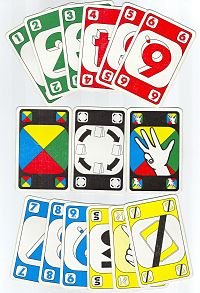Solo (card game)
| solo | |
|---|---|

|
|
| Game data | |
| author | Thomas Pauli |
| publishing company | Amigo |
| Publishing year | 1993 |
| Art | Card game |
| Teammates | 2 to 10 |
| Duration | 30 minutes |
| Age | from age 6 |
SOLO is a card game . It was published by Amigo-Spieleverlag under this name and is one of the numerous Mau-Mau variants from which Uno emerged . By January 2009, 900,000 games had been sold.
Course of the game
At the beginning, eight cards are dealt to each of the unlimited number of players. The colors are red, yellow, blue and green. Whoever has placed his penultimate card must call "Solo". If he forgets to do this, he receives two additional cards as a penalty. The winner is whoever is the first to run out of cards.
Action cards
There are also action cards in the deck of cards.
| map | action |
|---|---|
| +2 | The previous player receives two cards from the pile. The cards can be passed on by discarding them. |
| +4 | The next player receives four cards from the pile and the player who placed them then announces the color to be played. The cards can be passed on by discarding them. |
| → ← | Change of direction - with more than two players the direction of play is changed, with two players the card has the same function as the skip card. |
| (-) | Skip - the next player is skipped. |
| → ← | Card exchange - the player who played the card exchanges cards with any player. This is a novelty compared to the already mentioned rules on Mau-Mau and UNO. |
| [] → [] → [] → [] | The cards are passed in the direction of play (one round) (which is also a not yet known variant of the Mau-Mau and Uno rules). |
Individual evidence
- ↑ Hall of Fame at Amigo
Web links
- Solo in the Luding games database